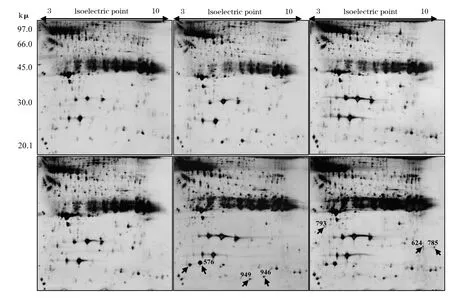肝移植并FK506联合用药后人血清蛋白质组的二维凝胶电泳分析
李 彦,王鸿丽, 赵永强,刘 煜,梁 艳
肝移植并FK506联合用药后人血清蛋白质组的二维凝胶电泳分析
李 彦1,王鸿丽2, 赵永强2,刘 煜3,梁 艳1
目的探索肝脏移植并FK506联合用药后人血清中蛋白质组的变化,研究免疫排斥反应的机制及FK506联合用药的作用。方法取5例肝癌患者移植前和移植后24 h、10 d、30 d、90 d、180 d的血清样品,用Aurum Serum Protein Mini Kit除高峰度蛋白,进行双向电泳(2-DE)分离,ImageMaster 2D Platinum图像分析软件分析电泳图谱。结果建立移植前和移植后并FK506联合用药的人血清双向电泳差异图谱,蛋白斑点数在(877±59)~(897±61),移植前、后不同组之间的匹配均>70%。共筛选出重复性好且表达显著差异的蛋白质斑点7个。结论初步建立了肝移植并FK506联合用药后人血清蛋白质组的2-DE分析方法。
肝移植;免疫排斥;免疫抑制药;FK506;血清;双向电泳
普乐可复(tacrolimus, FK506) 是大环内酯类免疫抑制药[1],目前已成为临床抗排斥反应的首选药物,用于肝脏或肾脏移植术后其他免疫抑制药物无法控制的移植物排斥反应[2,3],其体内作用机制还在深入研究中。免疫抑制药骁悉可改善肝移植术后服用FK506造成的肾损伤,常和激素一起与FK506联合用药[4,5]。由于蛋白质不仅是多种致病因子对机体作用最重要的靶分子,而且也是大多数药物的靶标,应用蛋白质组学等生物技术在发现新的药物靶标、论证药理作用及不良反应等方面已发挥了有效作用[6,7]。笔者采用蛋白质组学技术中的双向凝胶电泳(2-DE)技术,通过比较移植前和移植后蛋白质组的电泳图谱差异,寻找表达差异蛋白质,旨在从蛋白质组学角度探索肝移植后的免疫排斥机制,以及FK506联合用药的作用机制,为合理选择和使用免疫抑制药,以及探索免疫抑制药治疗方案提供线索。
1 材料与方法
1.1 样品来源 取5例武警总医院肝移植研究所肝癌移植患者(年龄27~65岁)移植前和移植后24 h、10 d、30 d、90 d、180 d的血清样品,共6组30个样品。移植后采用三联用药: FK506+骁悉+激素,3个月时停用激素,3个月内FK506浓度为8~10 ng/ml,3~6个月为6~8 ng/ml。
1.2 试剂 血清样品处理试剂盒(Aurum Serum Protein Mini Kit)购自BIO-RAD公司,3000 MW超滤管购自Sartorius公司,IPG胶条(ImmobilineTM DryStrip,pH3-10,NL,18cm)、IEF buffer ( pH3~10,NL)。CHAPS、十二烷基硫酸钠(SDS)、丙烯酰胺、甲叉双丙烯酰胺、三羟甲基氨基甲烷(Tris)购自GE公司。硝酸银、二硫苏糖醇(DTT)、碘乙酰胺等购自Sigma公司。
1.3 设备 PROTEAN等电聚焦电泳仪、垂直板电泳仪(PROTEAN Ⅱxi Cell)购自Bio-Rad公司。ImageMaster 2D platinum图像分析软件购自Amersham Pharmacia公司。UV160紫外分光光度计购自日本SHIMADSU公司,MIKRO 22R冷冻离心机购自德国Hettich公司。
1.4 实验方法
1.4.1 样品制备 血清中高丰度白蛋白和IgG的去除按照Aurum Serum Protein Mini Kit的操作方法,处理后的血清用3000 MW超滤管4 ℃、8000 r/min离心40 min,取上清。按Bradford法进行蛋白定量[8]。
1.4.2 双向电泳
1.4.2.1 第一向等电点聚焦 分别取180 μg处理后的血清,加入重泡胀液(8 M Urea、8%CHAPS、0.5% IEF buffer、微量溴酚蓝)至总体积350 μl,震荡混匀,均匀加入IEF聚焦槽中,胶条胶面朝下贴在混合液上,用矿物油覆盖胶条。聚焦参数:水化1 h;30 V 10 h;500 V 30 min;1000 V 30 min;2000 V 30 min;5000 V 30 min;8000 V 30 min;10 000 V至80 000 VHrs。
1.4.2.2 平衡 聚焦后的IPG胶条在含20 mM的DTT和碘乙酰胺平衡液(50 mM, 1.5 M Tris-Cl,pH8.8、6 M Urea、30%Glycerol、20%SDS、微量溴酚蓝)中分别平衡15 min。
1.4.2.3 第二向SDS-PAGE电泳及染色 用13%(T为13%,C为2. 6%)的SDS-PAGE凝胶分离,恒流20 mA/胶,40 min,30 mA/胶至溴酚蓝前沿至凝胶底部。应用硝酸银染色法染色[9]。
1.4.3 凝胶分析 应用Labscan扫描软件获取图像,用图像分析软件对2D凝胶图像进行点检测、校准、定量蛋白质点、匹配、比较等分析。差异蛋白质点的筛选使用图像分析软件和人工验证的方法,对比移植前后所有分离蛋白质斑点的%Vol值(包含在n个蛋白质点的一张凝胶中,蛋白质点X在所有点体积之和中所占的相对体积)。
2 结 果
获得免疫抑制药FK506+骁悉+激素联合用药在肝移植后人血清蛋白质的双向电泳差异表达谱(图1)。肝移植前后样本的生物学重复性为3次,由图像分析软件分析各电泳图谱,得到肝移植前和肝移植后24 h、10 d、30 d、90 d、180 d图谱的蛋白斑点数分别为(898±23)、(934±43)、(919±62)、(877±59)、(976±61)和(932±45)个,肝移植前和肝移植后的平均匹配率>70%以上。共筛选出表达量差异>2倍且在不同患者之间重复性好的蛋白质斑点7个(表1)。其中蛋白质斑点624移植后蛋白斑点显著上调(>3倍)且在移植后的不同阶段表达稳定;蛋白点785的表达量在移植前和移植后的不同时间段呈现逐渐上调变化;斑点793在移植后24 h表达量明显升高,且在随后的时间段表达量保持稳定;斑点576在移植后24 h后表达下调,在移植10 d后的不同阶段呈现出持续上调的变化。

表1 肝移植前后FK506联合用药的人血清显著蛋白差异表达 (%Vol)

图1 FK506联合用药在肝移植后人血清双向电泳的差异表达图谱
3 讨 论
近些年,蛋白质组学技术在发现药物靶点、阐明药物作用机制等方面的研究中发挥了极大的作用[10,11],但还未有免疫抑制药在人肝移植后抗排斥作用的蛋白质组学方面的报道。本研究将5例乙型肝炎肝硬化、肝癌移植前和移植后服用免疫抑制药FK506+骁悉+激素联合用药不同时间段的血清样品进行比较。样品采用BIO-RAD公司Aurum Serum Protein Mini Kit试剂盒特异性吸附白蛋白和IgG,用分子量3000 ku超滤管进行除盐和浓缩。经处理后样品的凝胶图谱蛋白质斑点数显著提高。初步建立了肝移植前和肝移植并FK506联合用药后24 h、10 d、30 d、90 d、180 d的2-DE差异表达图谱。笔者将进一步利用质谱技术鉴定差异蛋白质,以期从蛋白质组学角度深入探索肝移植后FK506+骁悉+激素联合用药的作用机制, 为进一步开展肝脏移植和药物治疗奠定基础。
[1] Starzl T E, Todo S, Fung J,etal. FK 506 for liver, kidney and pancreas transplantation[J]. Lancet,1989, 28(2):1000-1004.
[2] McCauley J, Fung J, Jain A,etal. The effects of FK 506 on renal function after liver Transplantation[J].Transplant Proc,1990 ,22(1):17-20.
[3] Tolou-Ghamari Z. Nephro and neurotoxicity of calcineurin inhibitors and mechanisms of rejections: A review on tacrolimus and cyclosporin in organ transplantation[J].J Nephropathol,2012,1(1):23-30.
[4] Rao V, Haywood S, Abecassis M,etal.A non-induction renal sparing approach after liver transplantation: high dose mycophenolate mofetil with delayed, low-dose tacrolimus[J].Transplant Proc,2013,45(1):320-322.
[5] Schmeding M, Kiessling A, Neuhaus R,etal.Mycophenolate mofetil monotherapy in liver transplantation: 5-year follow-up of a prospective randomized trial[J]. Transplantation,2011,92(8):923-929.
[6] Schenone M, Dancˇík V, Wagner B K,etal.Target identification and mechanism of action in chemical biology and drug discovery[J]. Nat Chem Biol,2013 ,9(4):232-240.
[7] Russell C,Rahman A, Mohammed A R.Application of genomics, proteomics and metabolomics in drug discovery, development and clinic[J]. Ther Deliv,2013,4(3):395-413.
[8] 汪家政,范 明.蛋白质技术手册[M].北京:科学出版社,2001:42-47.
[9] Mortz E, Krogh T N, Vorum H,etal. Improved silver staining protocols for high sensitivity protein identification using matris assisted laser desorption/ionization time of flight analysis[J]. Proteomics, 2001, 11: 359-363.
[10] Savino R, Paduano S, Preianò M,etal.The Proteomics Big Challenge for Biomarkers and New Drug-Targets Discovery[J].Int J Mol Sci, 2012,13(11):13926-13948.
[11] Miao Q, Zhang C C, Kast J. Chemical proteomics and its impact on the drug discovery process[J]. Expert Rev Proteomics, 2012 ,9(3):281-291.
(2014-02-18收稿 2014-05-06修回)
(责任编辑 尤伟杰)
Two-dimensionalgelelectrophoresisanalysisofhumanserumproteomeafterlivertransplantationandFK506combinationtherapy
LI Yan1,WANG Hongli2,ZHAO Yongqiang2,Liu Yu3,and LIANG Yan1.1. Department of Pharmacy, 3. Institute of Liver Transplantation, General Hospital of Chinese People’s Armed Police Forces, Beijing 100039, China;2. National Center of Biomedical Analysis,Beijing 100850, China
ObjectiveTo analyze the serum proteome change after liver transplantation and FK506 combination in human serum by two-dimensional gel electrophoresis (2-DE) and to study the mechanism of immune rejection and the mechanism of action of FK506 combination.MethodsThe serum samples of 5 liver transplantation patients pre- and post transplantation at 24 hours,10 days,30 days,90 days 180 days were treated using Aurum Serum Protein Mini Kit, and than analyzed by 2-DE. The electrophoresis images were analyzed by using ImageMaster 2D platirum imaging analysis software.ResultsThe differential maps of 2-DE of serum proteome before and after liver transplantation and FK506 combination were established. Protein spots between (877±59.65)-(897.6±61.01),the matching rate before transplantation and different groups after transplantation>70%. Among them 7 protein spots were selected with good repeatability and significant differential expression.ConclusionsThe 2-DE analytical method of serum proteome after liver transplantation and FK506 combination was preliminarily established. The differential expression protein spots found in the study have laid a foundation for the further study .
liver transplantation; immune rejection; immunosuppressant; FK506; serum; 2-DE
武警总医院二类课题(WZ2011019)
李 彦,本科学历,副主任药师,E-mail:lyanbjing@126.com
100039北京,武警总医院:1.药剂科,3.肝脏移植研究所;2.100850北京,国家生物医学分析中心
梁 艳,E-mail:ly.w.j@163.com
R617

